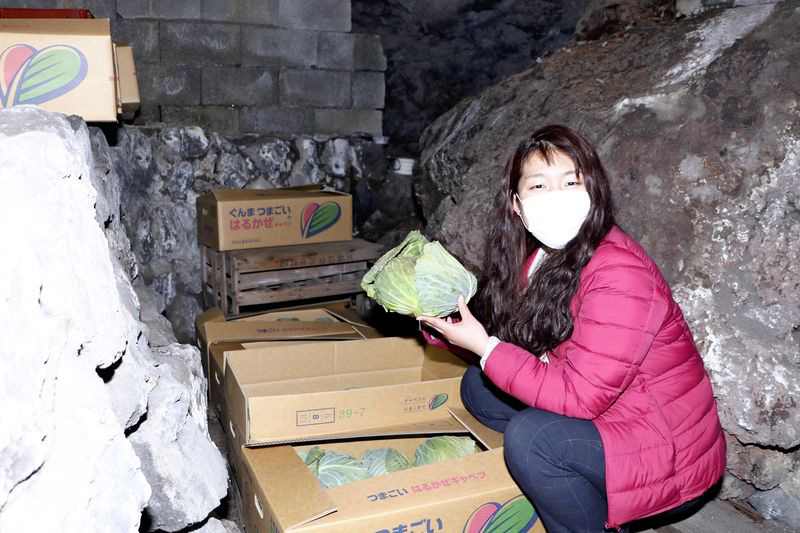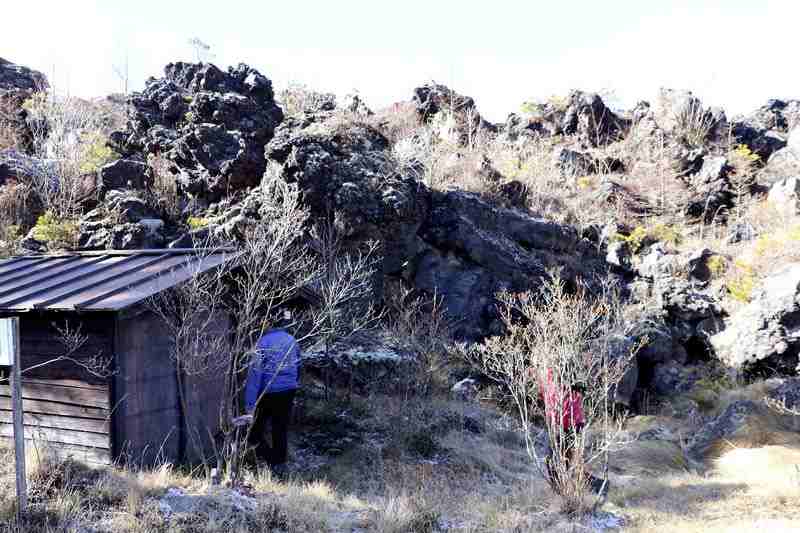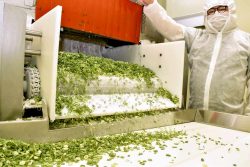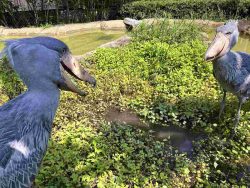
A woman holds a cabbage being stored in a wind cave in Tsumagoi, Gunma Prefecture, on Dec. 13
12:25 JST, January 4, 2022
TSUMAGOI, Gunma — Work has begun in Tsumagoi, Gunma Prefecture, to store locally produced cabbage in wind caves created by lava from Mt. Asama.
On a plateau 700 to 1,400 meters above sea level at the northern foot of Mt. Asama, 2,820 hectares of cabbage fields can be found.
The village produced 186,000 tons of cabbage between June and November, the largest such crop in the nation, according to the local Tsumagoi branch of the Japan Agricultural Cooperatives.
However, there were no facilities to store the produce for long periods of time, meaning the village was unable to offer tourists special dishes cooked with its cabbage in winter.
The aim of the project is to establish storage technology utilizing natural energy as the inside of the caves, or fuketsu, maintains a constant temperature throughout the year. Local farmers hope to market the cabbage as “fuketsu cabbage” and promote tourism.

Lava that spread north from Mt. Asama in Tsumagoi, Gunma Prefecture, in a 1783 eruption is seen on Dec. 13.
With the cooperation of a local tourism facility, the village and the village tourism association began storing 60 heads of cabbage on a trial basis in the wind caves in mid-November. They plan to offer a tour of the wind caves in February next year, during which dishes cooked with the fuketsu cabbage will be served.
Many wind caves formed from lava that spread 2 kilometers wide as it flowed 5.5 kilometers northward from the caldera at the top of the 2,568-meter volcano during the 1783 eruption, according to the village and others.
Air currents inside the caves change seasonally due to a difference in temperature between the outside and the underground, for example, making cold air flow in and out through gaps in the lava over the slope of the mountain. Because of this, the temperature inside is less than 5 C even in summer, and remains at around -5 C in winter, even when the outside temperature drops as low as -18 C.
Ice can be found on the floor of wind caves at Mt. Asama even in summer, making them highly effective as natural refrigerators, said Hidekazu Suzuki, an associate professor of natural geography at Komazawa University, who is well versed in the nation’s wind caves.
“If they succeed in storing cabbage there, it will be a good example of a sustainable use of natural energy,” he said.
There have been cases in which snow is used to store carrots and sake, among others.
“I’m looking forward to seeing how the cabbage being stored in the wind caves will change their taste,” said Motomi Matsumoto, 57, a cabbage grower in Tsumagoi.
Hideichi Hoshikawa, 65, president of the Tsumagoi cabbage promotion cooperative association, said, “We would like to establish the technology to keep the cabbages fresh in the caves and help revitalize the region.”
Related Tags
"Features" POPULAR ARTICLE
-

Sanrio to Open Museum in Yamanashi Pref. Dedicated to Founder, Exhibits Include Hello Kitty, Other Characters
-

Autumn Foliage Surrounds Visitors to Tokyo’s Showa Kinen Park
-

My Daughter No Longer Speaks to Me, But I Want to See Her and My Grandchild
-

Kumamoto: Public Bath Refurbished as Library Where You Can Chat, Take Photos
-

Frozen Vegetables: Demand Rises for Convenient, Tasty Domestic Produce
JN ACCESS RANKING
-

Keidanren Chairman Yoshinobu Tsutsui Visits Kashiwazaki-Kariwa Nuclear Power Plant; Inspects New Emergency Safety System
-

Imports of Rare Earths from China Facing Delays, May Be Caused by Deterioration of Japan-China Relations
-

University of Tokyo Professor Discusses Japanese Economic Security in Interview Ahead of Forum
-

Japan Pulls out of Vietnam Nuclear Project, Complicating Hanoi’s Power Plans
-

Govt Aims to Expand NISA Program Lineup, Abolish Age Restriction






















